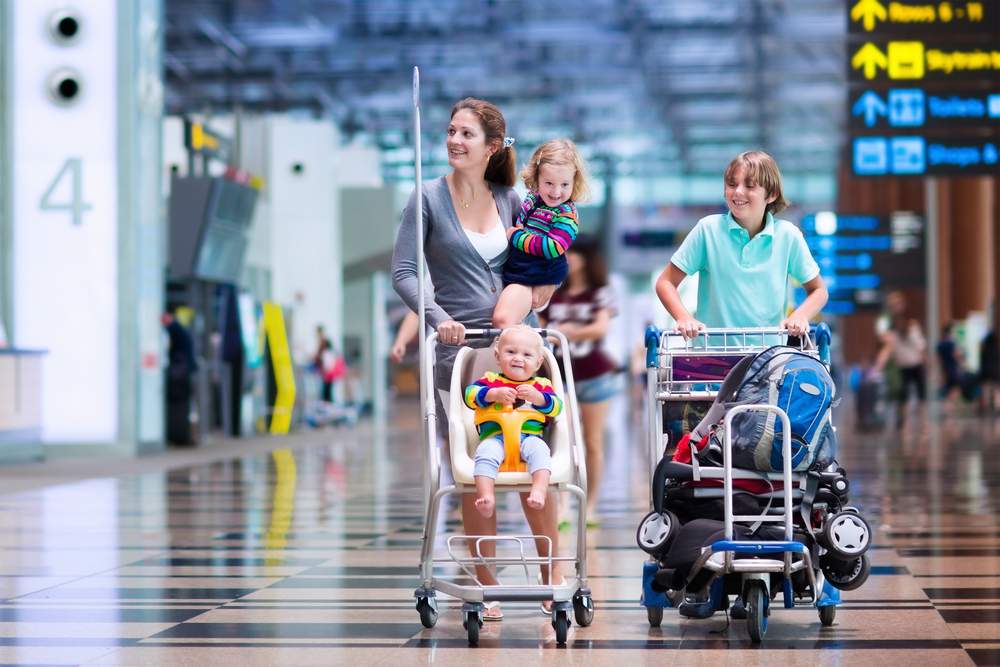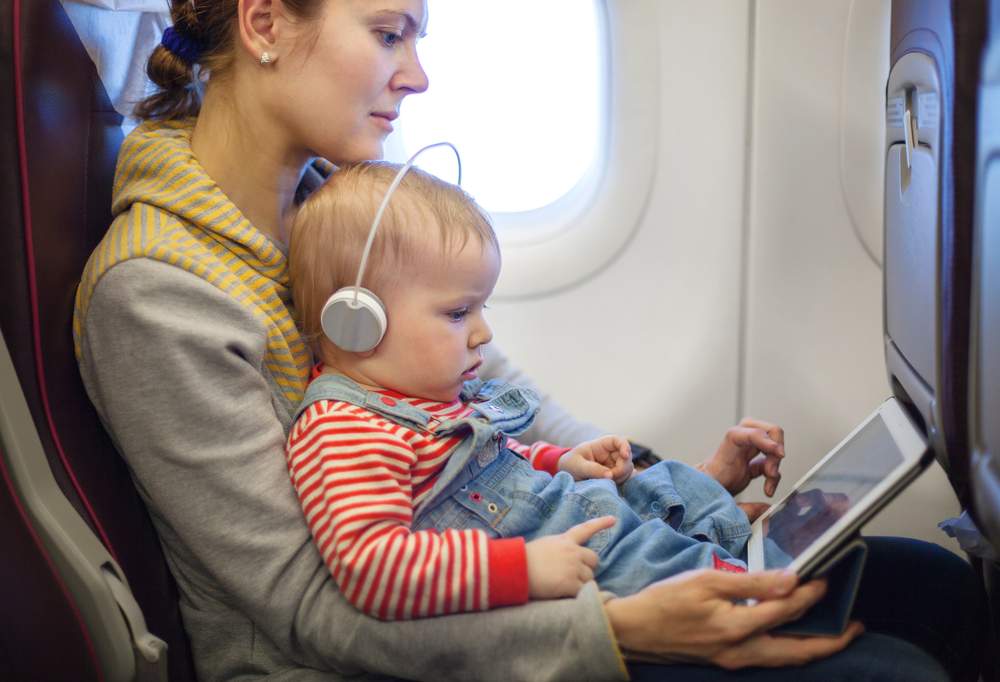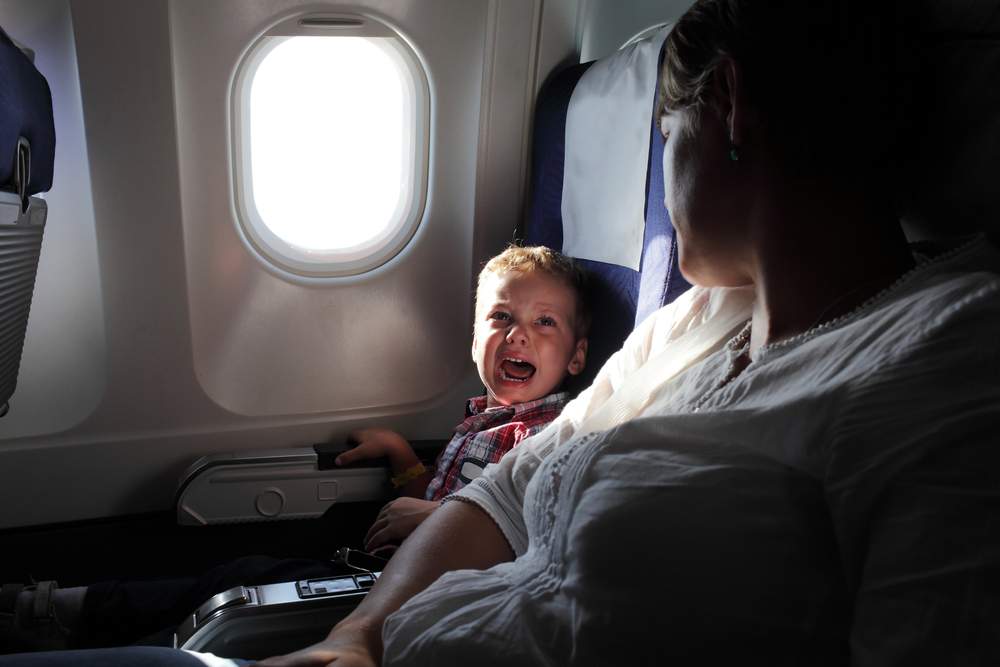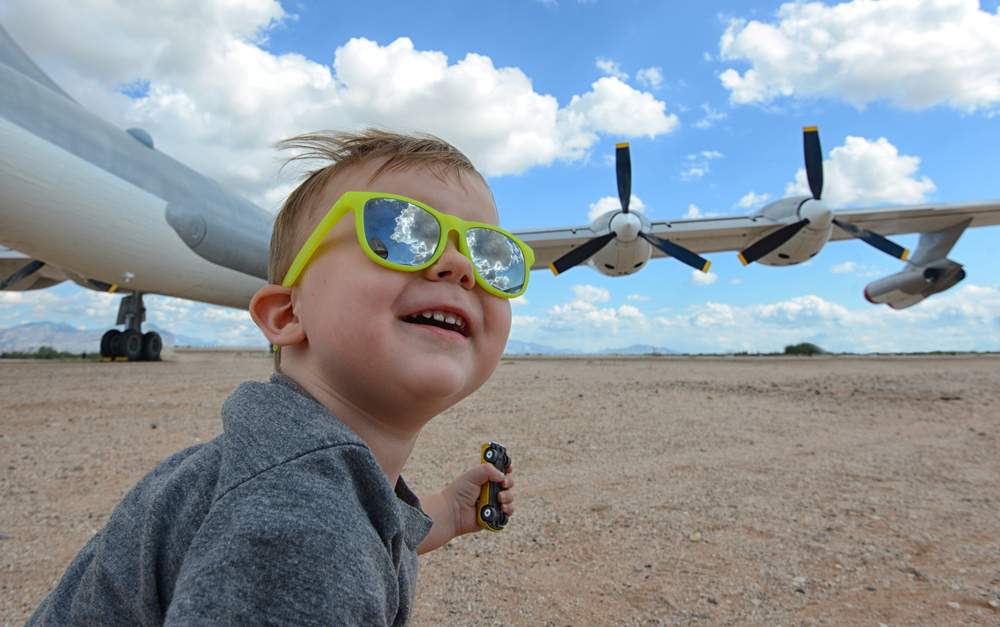If you’re a parent and you follow travel related news at all, then you are undoubtedly aware of the controversy surrounding flying with young children. Air Asia has special “kid free zones” on many of their flights, and Skyscanner launched a program that will allow people to know how many children are booked on a given flight, where they are located, and choose their seats accordingly. I think that’s a pretty good idea!
“It’s foolish to think you can just hop a flight with no preparation, and worse than foolish, it’s downright inconsiderate.”
While I am a firm believer that everyone is responsible to be patient and inclusive with all members of society, kids included, there is an additional burden on parents to do what they can to prepare kids to fly. It’s foolish to think you can just hop a flight with no preparation, and worse than foolish, it’s downright inconsiderate. If you’re staring down a plane journey with a toddler or young child, here are a few things you can do to prepare your child for the experience and stack the odds of a peaceful, successful flight for yourself, your child, and the other passengers around you.
Start at Home

A travel day, for children, is one long exercise in new (and potentially frightening) experiences, with an extra helping of high expectations and a stressed out parent as the cherry on top. A wise older mother once said to me, “You can’t expect your kids to do, in public, what they will not do at home.” Those words changed my parenting life and restructured much of our family’s focus. So many of the things that frustrate us as parents, in public, are our own fault, because we haven’t spent the time at home introducing our children to the socially appropriate behaviors. Don’t blame your kid for that.
“A wise older mother once said to me, ‘You can’t expect your kids to do, in public, what they will not do at home.'”
Building Patience & Attention Span
These are the two things that fellow travelers most wish parents would take in hand, and not just for flights, but for doctors’ offices, restaurants, and any other public place. What drives other passengers most crazy – noise level, temper tantrums, kicking their seats from behind, and running up and down the aisle – can be largely avoided by taking the time to build patience and attention span in your young child. These are not things that they magically grow into at some point, happily, they are things that we can build into their routines as lessons in civility and community living.
“What drives other passengers most crazy… can be largely avoided by taking the time to build patience and attention span in your young child. “
Teaching a child to show patience and stretching an attention span is not difficult, but it does take diligence, consistency, and a patient attention span on the part of the parent! If you work on it every day, over a period of months, you’ll find your two or three year old easily able to sit quietly with a book for half an hour or longer, and able to curb his enthusiasm when you ask him to do so.
How is This Accomplished? Practice.
Of course a three year old will not sit for several hours on a plane if he’s never been required to sit for five minutes at home. So, practice sitting. Not in the ‘time-out’ or punitive sense, but in the encouraging, proactive, happy sense.
- Begin by helping your child to sit for a few minutes, on either end of a meal, at the table.
- Build in five minutes of “book time” on a chair twice a day. When he can do five minutes, stretch it to seven, then ten.
- Sit at the table for ten minutes in the morning, and again in the afternoon, and do a quiet activity together that requires focus and attention.
- Give your child coping skills for when he begins to feel out of control. For our kids, we taught them to “Fold your hands and show self control.” It harnessed all of that energy and gave them a point of focus, their hands, while they waited. Sounds crazy, perhaps, but it works! Here’s a little rhyme that most pre-school teachers use to teach the trick: “Open, shut them, open, shut them, give a little clap! Open, shut them, open, shut them, lay them in your lap!” Do the motions and increase the odds for self control in public!
You’ll have to keep at this and work on it over a period of months before you see real growth, but you will.
It’s All Fun & Games…
Until someone freaks out in the security line up. I was flying back from the Ukraine with a child who was unable to hear in my care, a child who had no language whatsoever, as the orphanage hadn’t bothered to teach him any sign. A child who, until three days previous, had never been out of his care center. Imagine his distress when the security team in Zurich wanted to remove his shoes, his coat, and do a more thorough check. Of course with three days to get ready, and no language to communicate with, there wasn’t much of a way to prepare, so we played follow the leader, I smiled a lot, and we made it through.
“Preparing kids for security is fun and easy, and you can do it at home for weeks in advance.”
Preparing kids for security is fun and easy, and you can do it at home for weeks in advance. Play TSA with a door frame as your scanner and a paper towel tube scanning wand. Take turns walking through without touching the sides, taking your shoes and coat on and off on either side, placing the contents of your pockets into a plastic basket, and passing it through to the “agent” on the other side, and reassuring the teddy bear that it will be okay, he’ll come through the scanner just fine.
Some other games you can play to facilitate travel days
Ducklings (follow the leader): Take turns being the mama duck, encourage quiet quacking of the ducklings!
Halt!: Make it FUN for your child to stop quickly! Play this game all the time, randomly saying, “Halt!” and rewarding your child when she stops on a dime. This is a fun game if you play with a sense of humor and is one of the biggest safety skills your child needs to master if you’re going to travel.
Structure For Success

The most obvious way to prepare for a flight with young children is to structure for success:
- Book the flight for your child’s best time of day
- Leave plenty of extra time so that there’s no need to rush a reluctant little one or add additional, unnecessary stress
- Make it a fun, special day with lots of treats and joyous interaction
- Eat properly for a full 24 hours before your flight and the day of, don’t load them up on sugar and food dyes and then wonder why you’re peeling them off the ceiling
- Get a good night’s sleep – YOU – not just the kid
On the Flight
Once you’re on the flight, your main concern has to be keeping your child content, for his sake, and that of the passengers around you. This is the time to get creative, pull out all the stops, and make exceptions to every rule.
A dad of a toddler said to me recently, “Well, we don’t really “do” electronics at home for our kids, so I don’t feel like I should let them use it on the plane.”
“The plane is definitely the place to plug them in and let them play in the virtual world, since they can’t get up and run.”
What? Really? Our kids have had a very “unplugged” childhood, which is why I rejoice with them at the availability of in-seat entertainment and iPads on the planes. The plane is definitely the place to plug them in and let them play in the virtual world, since they can’t get up and run.
This is just about the only time you’ll find me arguing in favor of electronics for young children, but extreme days call for extreme measures. If YOU at thirty something years old are bored on a six hour flight, how much more so is the child who has no context for the experience. Make exceptions to the rules.
Pack Comfort Items
As a fellow passenger on the plane, may I formally request that you bring that nasty, ratty baby blanket your kid has been dragging everywhere for three years? I know it’s an embarrassment to look at, but your child is so beautifully content sucking on the corner of it.
Bring the stuff that matters to your kid:
- Let them wear their favorite clothes
- Bring their favorite lovies
- Read their favorite books
- Pack their favorite snacks
Pack a Secret Weapon
My almost 13 year old asked me, yesterday, on the train, if I’d packed a
secret weapon. I looked at him like he’d lost his mind. I haven’t packed a secret weapon in at least five years, but clearly, they still remember it!
What is a secret weapon? A stash of surprises to parcel out to extend happiness and stave off meltdown.
Your secret weapon might include:
- A new coloring book and crayons
- Wikki Stix
- Sewing cards
- Stickers and paper to stick them on
- A few small dollar-store toys
- A kaleidoscope
- A matchbox car
- Squinkies
You get the idea. Deploy one item at a time, stretching the fun out as looooong as possible!
When the Kid Freaks Out

Hopefully, this won’t happen, and if you’ve prepared carefully and stacked the deck, then the odds are greatly reduced, but if it does happen, here’s my advice. Consider those around you. Do whatever it takes to end the event and realize that even if you’ve broken all of your self imposed rules, it’s only one day, and peace for all at that particular moment is your primary concern.
“Let the haters hate, and do the best you can. It’s all anyone can ask.”
If it’s impossible, if the little dictator has decided that this is a good day to die and to take you with him, then hang in there. Every parent (who is honest) has been there, and it’s only one day of your life. Let the haters hate, and do the best you can. It’s all anyone can ask.
Five Bonus Tips

You can teach your kids these tips at home that will help facilitate your travels:
Bum Spots
This is not a disease, it’s a trick I discovered when I had two four year olds, a two year old and a baby and going ANYWHERE was a goat rodeo.
At the time IKEA was selling these little round woven chair pads in bright colors, just the right size for a little bum. I let the kids pick out one in their favorite color and then convinced them that they were the BEST place to sit while watching movies at home, while listening to stories before bedtime, and when coloring before lunch. In this way the children were quickly and happily brainwashed to believe that their “bum spots” were the BEST place to hang out and have fun.
“In this way the children were quickly and happily brainwashed to believe that their “bum spots” were the BEST place to hang out and have fun.”
On the day I was set to donate blood, I loaded up the kids and tested my theory. I tossed the bum spots out around the edge of the clinic and the munchkins plopped down, and to the amazement of the nurses, didn’t move an inch for a full thirty minutes.
For the next several years those bum spots saw a LOT of use: libraries for story hour, doctor’s offices when I didn’t want them touching nasty infectious toys, ferry waiting rooms, in great-grandma’s nursing home, family reunions, and more.
Hands on the Wall
More than once we’ve reduced strangers to giggles when they come upon our family at the counter of a fast food restaurant and find four little people with both hands flat against the wall (or counter) with their feet slightly spread.
They look like little convicts, lined up for a police pat down. In fact, what they are doing is exercising self control and remaining in ONE SPOT long enough for Mama to turn her attention to something else for thirty seconds without wondering what the herd was up to!
We came upon the idea when our second child was born and we had to get one kid out of the vehicle, then turn our backs to get the baby.
“Put your hands on the car/wall,” is one of those phrases that will turn out to be SO handy if you teach your child to obey instantly. Make a game out of it at first, seeing how fast your child can comply and rewarding them handsomely.
“Make a game out of it at first, seeing how fast your child can comply and rewarding them handsomely.”
For years our kids would automatically get out of the car and put their hands on the back quarter panel while they waited for us to collect the baby, stroller, or whatever else we needed before heading into the grocery store.
The ability to keep out of traffic in the parking lot is a health and safety consideration! We used Hands on the Wall! for restaurants, waiting in train terminals while tickets were being ordered, waiting on grandparents who were taking a little longer than the toddlers liked in public places, and any other time when we needed little people to STOP and be STILL for a few minutes. Just for fun, I tried this on my teenagers this week… it still works!
Tooth Brush Drills
Perhaps the number one way people become ill when traveling is from ingesting local water that contains contaminants, or parasites, or some other ugly, microscopic critter. Remembering not to drink the water is easy.
Remembering not to rinse your toothbrush, is not. Tooth brushing is one of those things we do on autopilot, and we have to retrain ourselves NOT to use sink water when we do it.
- Randomly announce that the bathroom has been transported to Mexico, or North Africa, or Myanmar, and as such, the water is not to be trusted.
- Place a water bottle by the sink and teach your children how to rinse their tooth brushes, swish and spit using only the water in that bottle.
- Make it fun by making a loud buzzer noise if a child touches the faucet, or by announcing that the child has contracted some horrible plague and must now take his medicine (make it fun medicine, this is a game!)
Our youngest child, at three, was the toothbrush police when we traveled. He’d be the one yelling loudly from the bathroom, “DON’T DRINK THE WATER!! DON’T RINSE YOUR TOOTHBRUSH!! YOU’LL BE SORRY!!!!”
International Dinners
Many parents worry about their children’s eating habits as they travel. Some children are very difficult when it comes to meal times, and encouraging flexibility and dietary branching out can be a real challenge. One of the ways that we encouraged a broad palate in our children, from the time they were babies, was to have an international dinner at least once a week.
- Choose a country and head to the library (or search on line) for recipes native to that place.
- Shop for the foods and do the cooking together with your kids.
- Decorate the table with a map of that country, or a drawing of the flag your child makes.
- Find some music from that country to play, and maybe a story book about life there, or the mythology of the culture.
- Don’t just introduce a new food, introduce a new people, place, and type of life experience.
These are the tiny steps that are easy to take in world schooling our children without ever leaving home.
We often tried to schedule the international dinners to coincide with evenings when we were having guests for dinner. Other families are often eager to join the party and bring something they’ve learned about that country to share. If you can find an actual PERSON to invite to dinner (or perhaps even cook with your family) so much the better!
“Don’t just introduce a new food, introduce a new people, place, and type of life experience.”
The goal of this game is to make foreign people, places, and their foods less scary to skeptical little people.
There are cultures in which refusing food is the height of rudeness, and our children need to be prepared to honor their hosts, be grateful for what is set before them, and try anything. Besides, sometimes they find that the slimy looking green stuff on top of their tacos (nopales-cactus paddle) is actually their new favorite thing!
Bathroom Fun
Children are notoriously amused by bathrooms, at home and abroad. I’ll never forget my oldest son’s first encounter with a bidet in Mexico City or the slightly disturbed and violated look on his face after attempting to use it for the first time! We never quite got over the jokes about squatties in southern Italy, Africa, and Asia… but then, we have three boys.
In our usual vein of, “Let’s prepare them at home before being embarrassed abroad,” we practiced for “different” bathrooms at home. How? By posting a sign that informed users the bathroom was now in Germany and no one could use it without paying fifty cents, or Mexico and in order to get a few sheets of toilet paper one would need to pay a quarter to whichever family member had been designated the keeper of the toilet paper.
If you want to get really “authentic,” take the toilet paper out altogether and put a plastic coke bottle with a hole drilled in the cap by the toilet filled with water… portable bidet like we saw over and over in Tunisia.
This game is the MOST fun if you wait to play it until you have friends over for the day!
For more on traveling as a family, check out the following articles:





